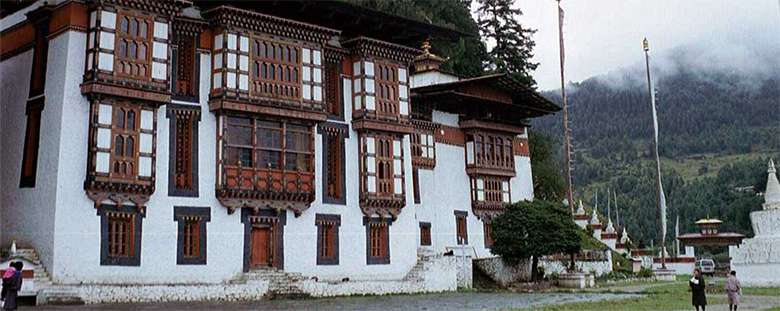

Kurjey Lhakhang of Bumthang Valley is tucked away on the beautiful green meadow next to the bank of the meandering river Chamkar. Jambay Lhakhang is 1 kilometer from Kurjey Lhakhang, which is 5 km from Jakar town. 108 Duduel or Jangchub Chortens, small chortens, serve as its enclosure. One of Bhutan’s most important historical and spiritual sites is Kurjey Lhakhang. The last resting site of the first Three Kings of Bhutan is Kurjey Lhakhang or Kurjey Monastery in the Bumthang valley. Many tourists have been drawn to Kurjey Lhakhang by its magnificent architecture and priceless artifacts. After Guru Rinpoche meditated in a cave to calm the enraged spirit, the structure earned the name Kurjey Lhakhang.
There is a fascinating story behind the construction of Kurjey Lhakhang. As per the traditional legend, during the 8th century, Sindhu Raja, the king of the iron castle of Bumthang, fell ill, and one of his attendants invited the revered tantric Guru Padmasambhava, who brought Buddhism to Bhutan to cure Sindhu Raja with his supernatural powers.
Guru Rinpoche found out that the King’s illness was caused by the local deities including the powerful Shelging Karpo. It is said that the King after his son’s death desecrated the abode of the chief deity of Bumthang, Shelging Karpo, who then angrily took revenge by turning the sky black and stealing the King’s life force, bringing him to near death.
After finding the cause of the illness, Guru Rinpoche chased the deities into a cave and meditated inside the cave for three months. Guru Rinpoche then subdued the deities including the powerful Shelging Karpo and left his body imprint ‘kur’ (body) ‘jey’ (imprint) inside the cave, thus giving the name Kurjey.
Beside the Monastery visitors can see a tall cypress tree that is believed to have sprouted from the walking stick of Guru Rinpoche which was planted to seal the agreement of Shelging Karpo agreeing to be the protective deity of Buddhism. During the visit to Kurjey Lhakhang visitors can see the Lhakhang is made up of three buildings.
Guru Lhakhang is the oldest structure which was built in 1652 by Mingyur Tenpa, while he was Trongsa Penlop and before he became the 3rd Desi of Bhutan, around the cave where Guru Padmasambhava meditated. Sampa Lhakhang is the second Lhakhang which was built in 1900 under the commandment of His Majesty Ugyen Wangchuk, the first king of Bhutan. The third Lhakhang, Ka Gon Phur Sum which means Three Mystic Revelations of The Eight Pronouncements (Kagye), Abhipraya Samaja (Gongdue), and Vajra Kilaya (Phurpa) was built in 1984 along with the 108 chortens under the order of Her Majesty the Queen Mother, Ashi Kesang Wangchuck.
The mystic aura of Kurjey Monastery has ensnared the heart of many travelers where they can still feel the presence of revered Guru Padmasambhava in the cave where he left his imprint. From astounding legend about the protector deity to the breathtaking architecture and sculpture depicting Guru Padmasambhava subduing cycle, Kurjey Lhakhang with its magnificence never ceases to amaze the visitors.
Apart from the monsoon season, Kurjey Lhakhang can be visited at any time of the year. You can also visit Kurjey Lhakhang, one of the holiest Buddhist shrines in Bhutan at any time of the year, however, during the prayer hours in the morning is considered to be the best time to pay a visit to this shrine. Don’t wait; visit one of the most historical places in Bhutan with the help of a pocket-friendly Bhutan package.
Quick Enquiry